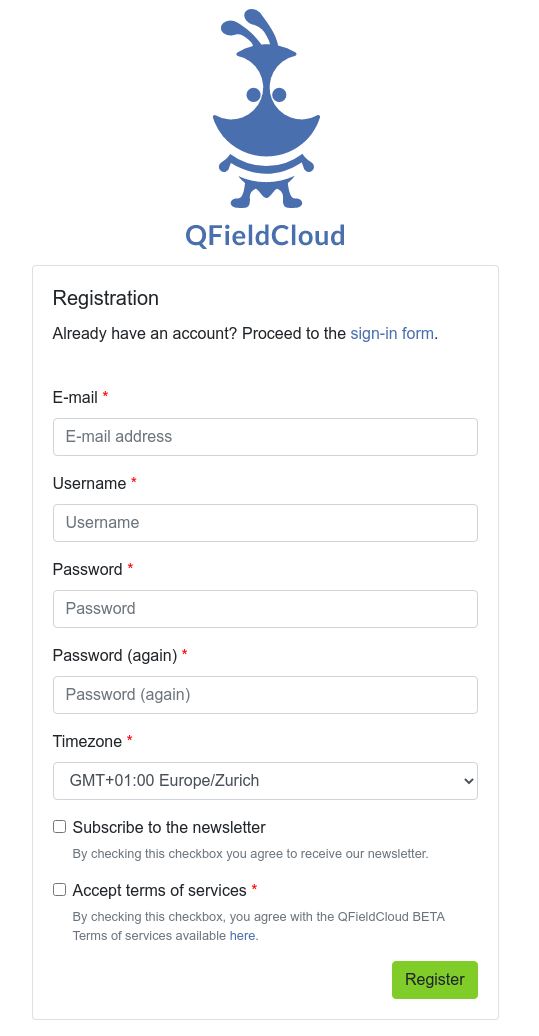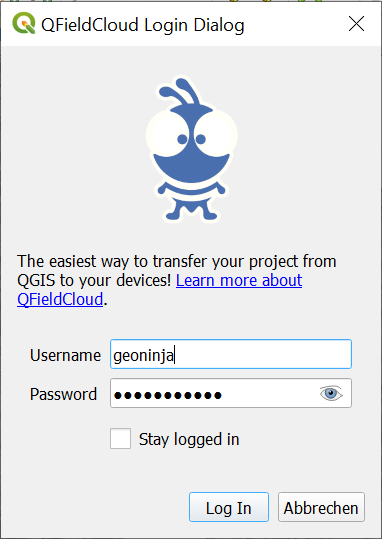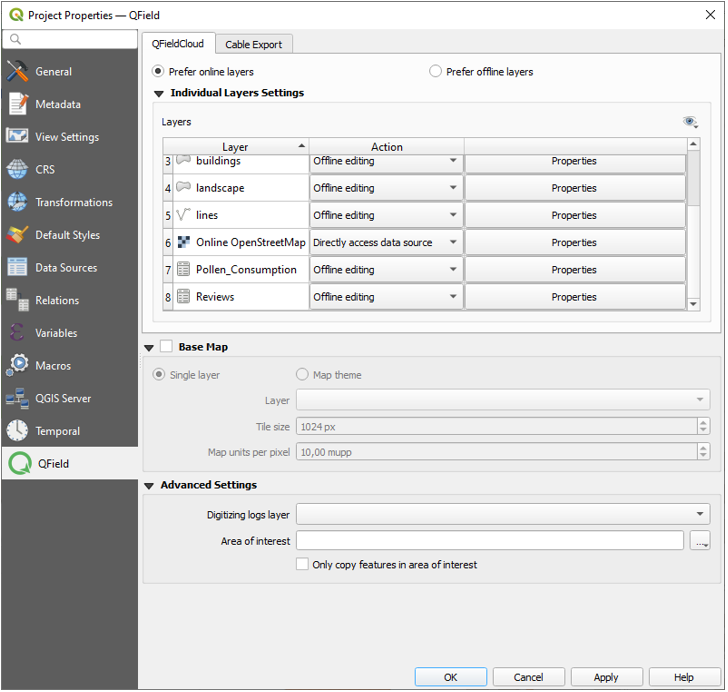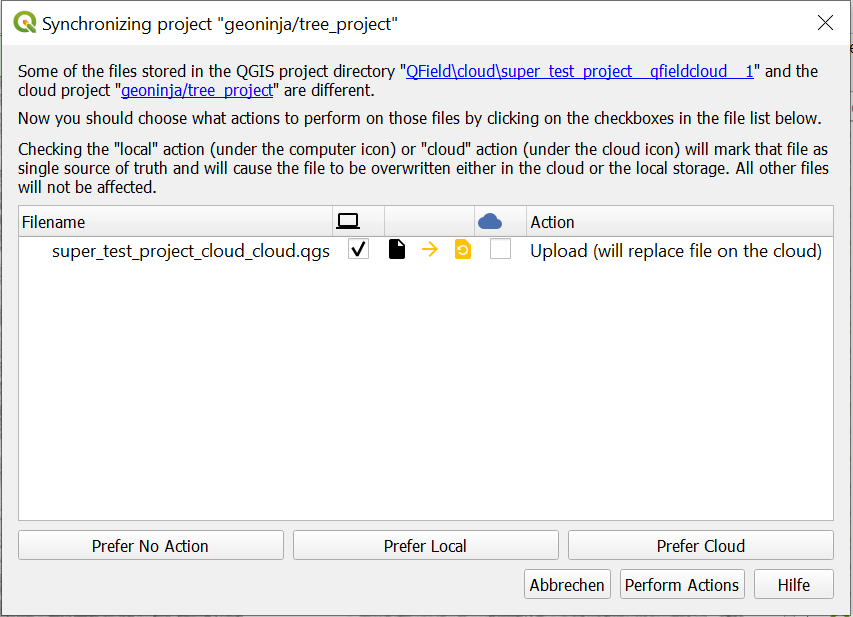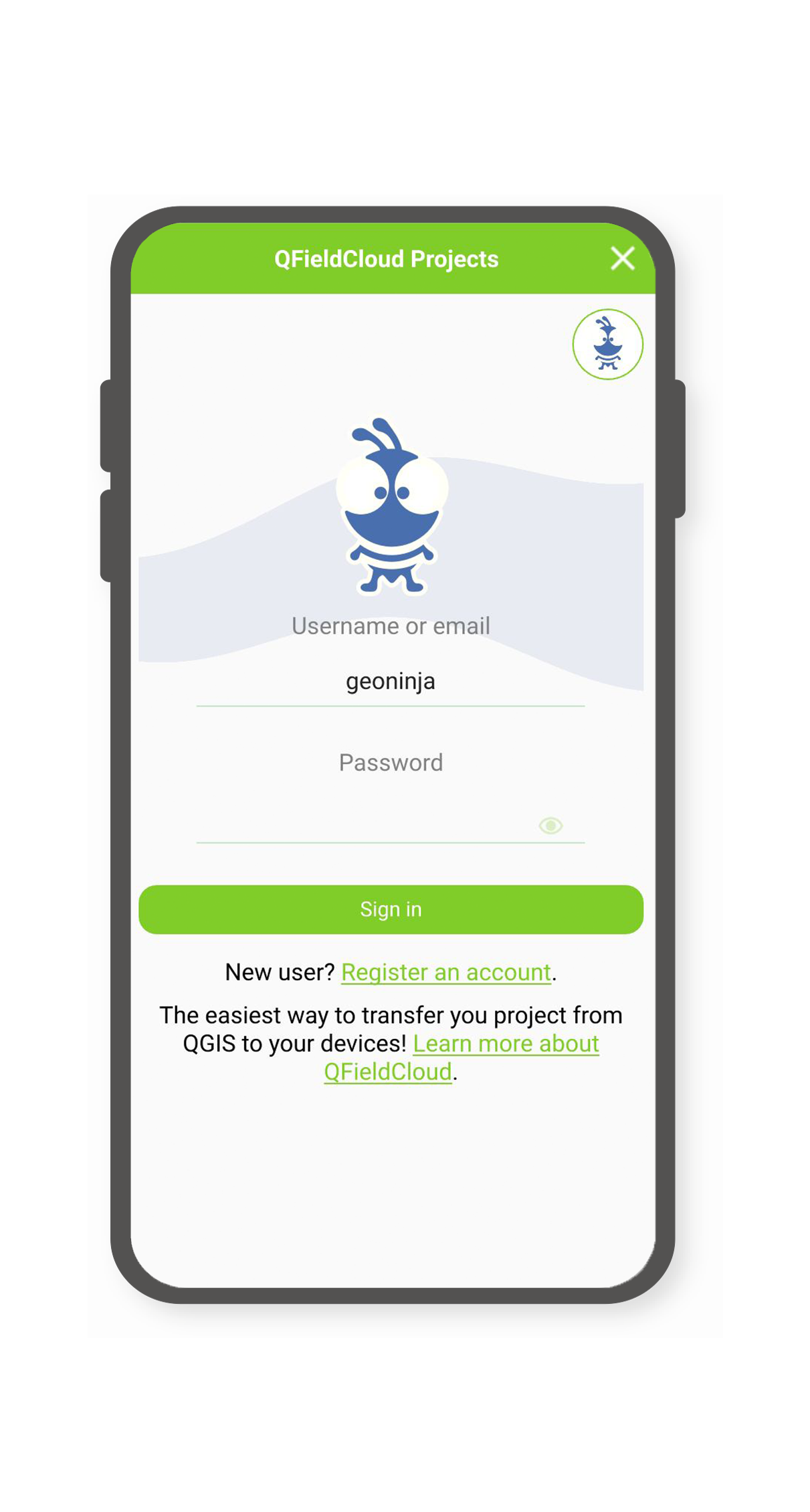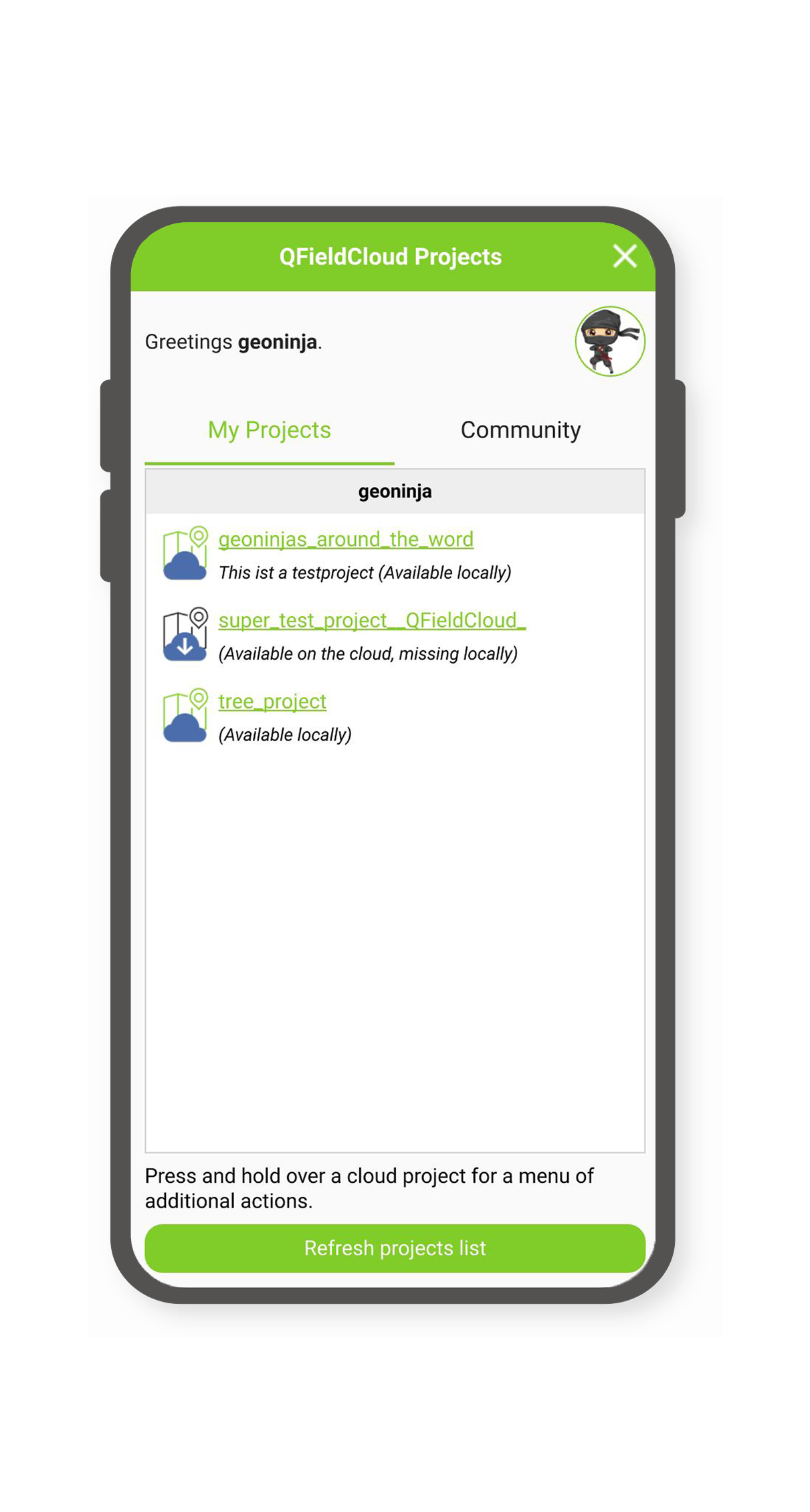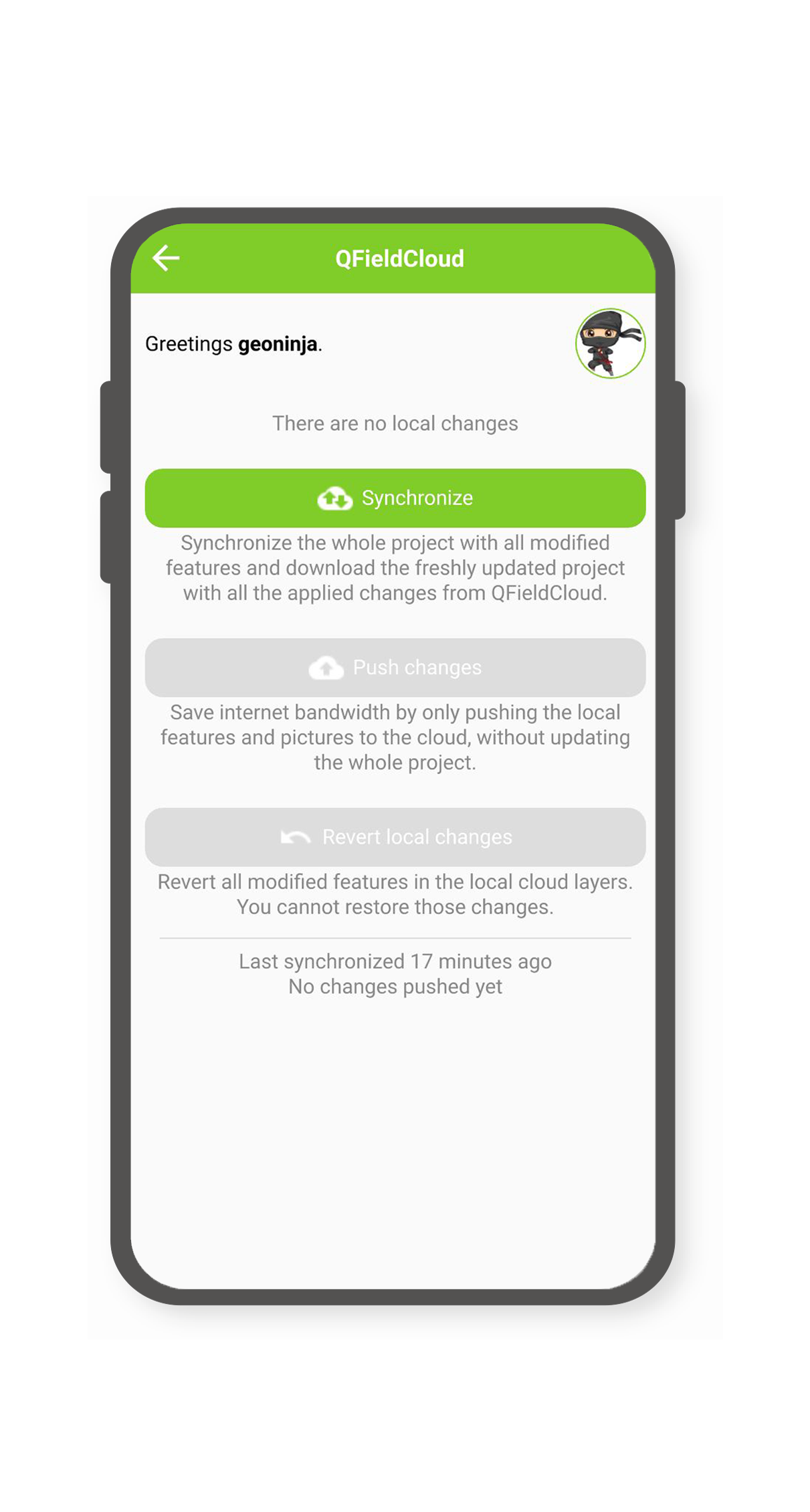Guida introduttiva¶
Get a free QFieldCloud account¶
Preparazione da Desktop
Go to the signup page, enter your details and create a new QFieldCloud account.
Edit your profile¶
Cambia le tue impostazioni personali. Aggiungi una foto del profilo o verifica la tua proprietà o partecipazione in organizzazioni.
View your cloud projects¶
Cerca e scegli un progetto dalla lista o inizia a creare un nuovo progetto.
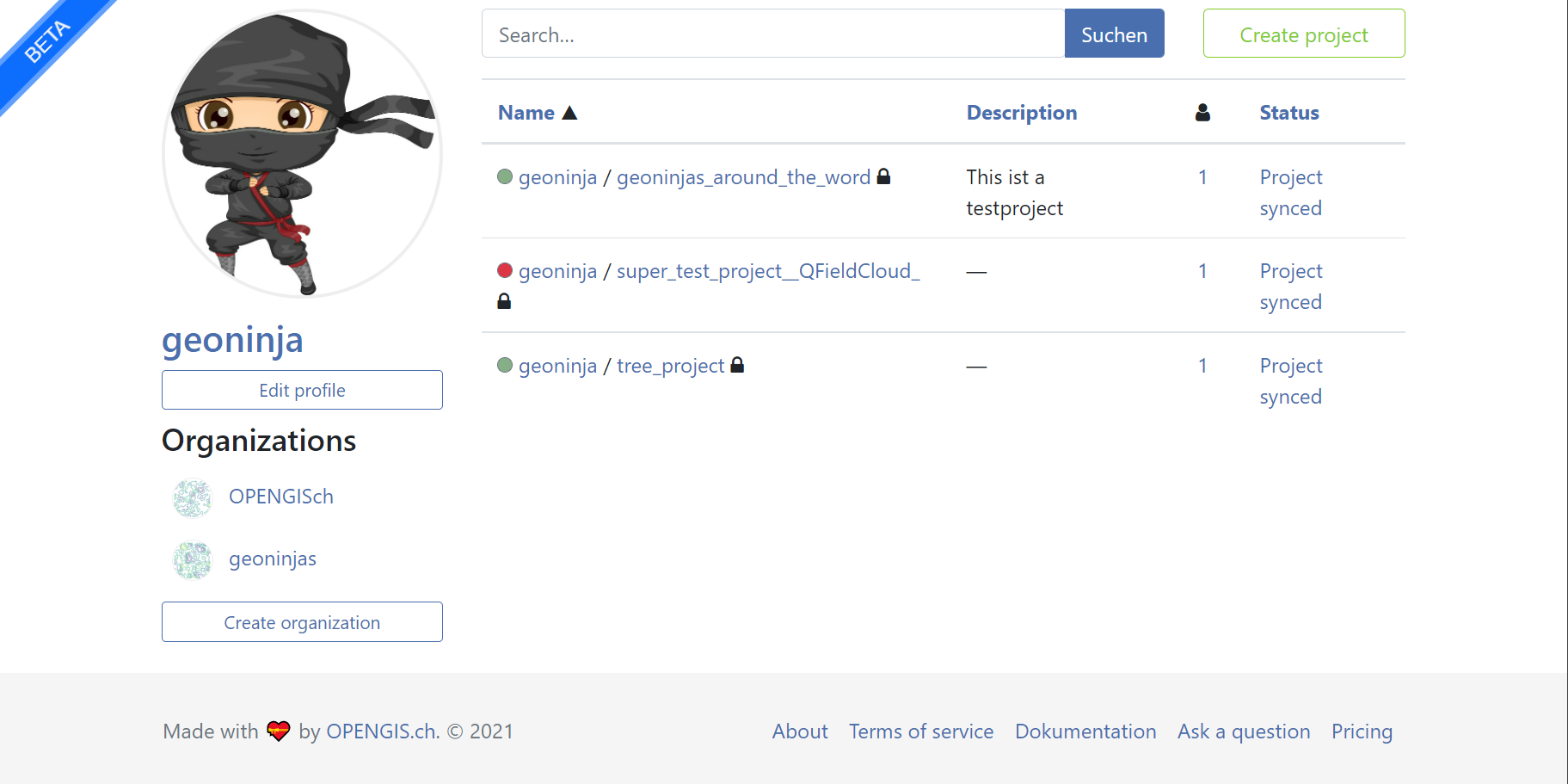
Connect to QFieldCloud on QGIS Desktop¶
Preparazione da Desktop
In order to connect to QFieldCloud, you need the QFieldSync plugin in QGIS. The next steps show you how you can install and synchronize your data to and from QFieldCloud.
Installa QFieldSync¶
Apri il gestore di plugin di QGIS andando nel menu Plugins -> Gestisci ed Installa Plugins....
Trova QFieldSysc nella lista dei plugin e installa l'ultima versione cliccando sul pulsante Installa Plugin.
Note
Visto che QFieldCloud si trova ancora in una fase beta, possono esserci frequenti aggiornamenti e correzioni. Per favore aggiorna QFieldSync spesso. In caso di problemi, prova ad aggiornare all'ultima versione prima di segnalare il problema.
Quando l'installazione è completata, appare una nuova barra degli strumenti.

Login di QFieldCloud¶
Clicca sull'icona 
Inserisci le credenziali precedentemente create durante la registrazione dell'account.
Note
If you use a password in QGIS for the first time, it will ask you to set a master password that manages all the other passwords used in QGIS. More information about the master password here: QGIS documentation
Esplora la schermata di panoramica dei progetti: il tuo utente attuale sottolineato e blu, un pulsante di logout in basso a sinistra, un pulsante cloud per creare un nuovo progetto e, sulla destra, un pulsante di aggiornamento per ottenere l'elenco dei progetti più recenti. Gli utenti appena registrati vedranno una tabella vuota e non appena creeranno nuovi progetti, la lista crescerà. La schermata di panoramica dei progetti appare così:
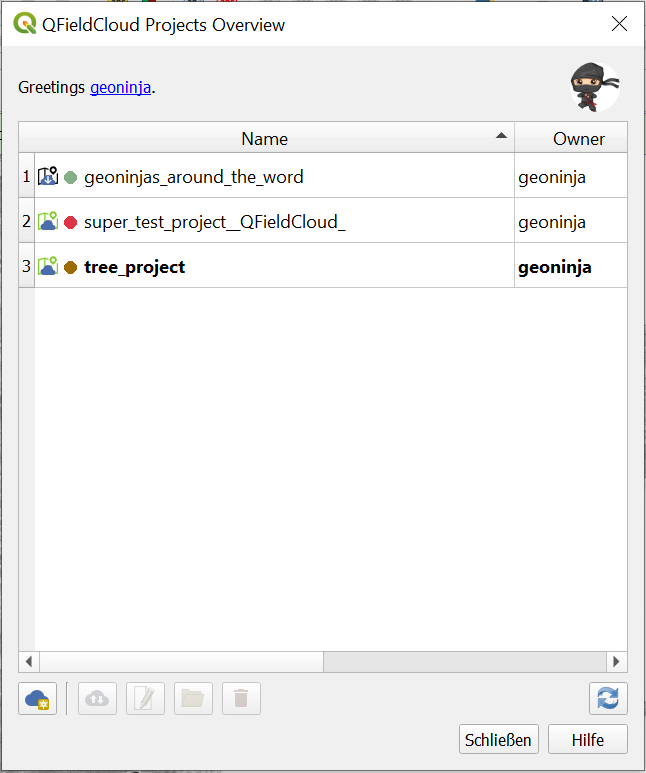
Le icone mostrano lo status cloud e locale dei differenti progetti.
Stato locale:


Stato cloud:
Rosso: stato fallito —> il progetto non è valido e non è comprensibile dal cloud. L'utente deve sistemare/caricare il proprio progetto .qgs/.qgz. Marrone: stato occupato —> stiamo lavorando sul tuo progetto, per favore sii paziente. Non puoi fare molto con il tuo progetto nell'attesa. Verde: stato ok —> il progetto è interpretato correttamente dal cloud. Puoi provare a scaricarlo su QField, ma il successo non è garantito.
Lo stato di ogni progetto è mostrato con un tooltip.
Facendo un doppio clic su un progetto nella lista, puoi vedere e modificare le proprietà del progetto.
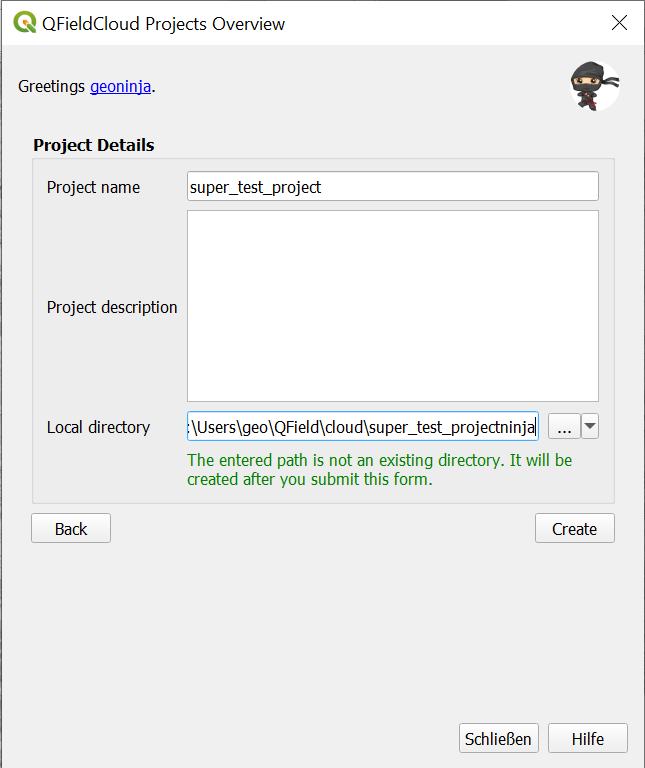
Create and configure your cloud project¶
Crea un nuovo progetto cliccando sul pulsante del cloud, in basso a sinistra. Per prima cosa, dovrai scegliere come creare il nuovo progetto fra
- "Converti il progetto aperto attualmente in un progetto cloud" Un nuovo progetto compatibile con QFieldCloud è creato a partire dal progetto attualmente aperto in QGIS. Per fare questo, i dataset verranno copiati in una directory di esportazione che fungerà da mirror locale. I dataset vettoriali saranno convertiti nel formato geopackage per facilitare la sincronizzazione tra differenti dispositivi mentre altri tipi di dataset saranno copiati nella nuova posizione del progetto.
Per convertire un progetto attuale, una directory completamente vuota è obbligatoria.
- "Crea un nuovo progetto QFieldCloud" Un nuovo progetto QFieldCloud vuoto sarà creato. Sei responsabile di spostare tutti i file relativi al progetto nella directory locale selezionata, assieme al file del progetto e le sue sottodirectory. Il file del progetto sarà trasferito solamente quando premi il pulsante di sincronizzazione. Verifica che la directory selezionata contenga al massimo un progetto QGIS.
Un modulo ti domanderà il nome del progetto, descrizione e directory locale. Nella directory locale puoi avere diverse situazioni:
- Il percorso inserito non contiene ancora un progetto QGIS.
- Il percorso inserito contiene un progetto QGIS.
- Per favore scegli una directory locale dove salvare il progetto.
- Il percorso inserito è un percorso relativo. Per favore inserisci il percorso assoluto di una directory.
- Il percorso inserito non corrisponde a una directory. Per favore inserisci un percorso valido.
- Il percorso inserito non corrisponde a una directory esistente. Verrà creata dopo l'invio del modulo.
- Sono stati trovati più progetti QGIS nella directory. Per favore lascia solamente un progetto QGIS nella root della directory.
Configura i layer del progetto per QField¶
Configura i layer del progetto facendo clic sulla quinta icona nella barra degli strumenti QFieldSync ! . Qui puoi configurare le azioni del layer QFieldCloud. La maggior parte delle volte devi configurare una preferenza per i layer online o offline. Per un controllo più preciso, nelle impostazioni avanzate è possibile configurare l'azione layer per layer. Puoi ottenere maggiori informazioni su come configurare i layer nella Guida introduttiva a QFieldSync!.
È raccomandato di usare layer GeoPackage per editing collaborativo. Consulta la guida Setup avanzato per avere maggiori informazioni a proposito dei formati vettoriali supportati.
Note
Se usi data source sperimentali senza una chiave primaria (es. Shapefile, GeoJSON, ecc.), devi avere un campo chiamato fid (in minuscolo) che sarà usato come chiave primaria per definire univocamente ogni elemento.
Ogni formato di layer raster e vettoriale può essere usato per dati in sola lettura.
Caricare un progetto¶
Una volta configurato, puoi premere il pulsante con la nuvola per aprire il dialogo di sincronizzazione. Qui devi decidere cosa preferisci: il file locale o il file sul cloud.
Adesso dovresti vedere il tuo progetto e i tuoi file su QFieldCloud
Dispositivo mobile¶
Lavoro sul campo
Installa QField¶
Download and install the latest version of QField from Google's play store, Apple's app store, or by downloading the lastest release for Windows, Linux, or macos.
Comincia a lavorare sul tuo progetto.¶
Login con il tuo username e password
Scegli un progetto da scaricare sul tuo dispositivo:
Synchronize your changes¶
Make a change to your data. Either create a new feature, delete a feature, or modify the geometry or attributes. Click the blue cloud button on the top left of the screen:
Scegli un'azione con la modifica che hai fatto ai tuoi dati. Ognuna delle azioni ha una spiegazione di ciò che dovresti aspettarti che accada:
Le tue modifiche sono adesso disponibili a chiunque abbia accesso al tuo progetto sul cloud.
Si possono trovare ulteriori informazioni su Configurazione avanzata QFieldCloud e Referenze tecniche di QFieldCloud.
